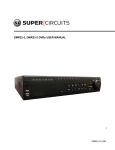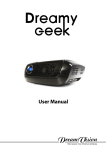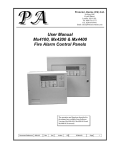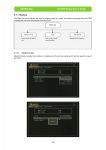Download DS-7304HFI-SE DVR USER`S MANUAL Version 1.2
Transcript
DS-7304HFI-SE DVR USER’S MANUAL Version 1.2 User Manual of DS-7304HFI-SE DVR Hikvision® Network Digital Video Recorder User Guide Copyright © 2010, Hikvision, Ltd. All rights reserved. This document may not be copied in whole or in part or otherwise reproduced without prior written consent from Hikvision except where specifically permitted under US and international copyright law. The information in this document is subject to change without notice. Hikvision assumes no responsibility or liability for any errors or inaccuracies that may appear in this book. This manual is written for DVR firmware version 1.2. 2 User Manual of DS-7304HFI-SE DVR Preventive and Cautionary Tips Before connecting and operating your DVR, please be advised of the following tips: • Ensure unit is installed in a well-ventilated, dust-free environment. • Unit is designed for indoor use only. • Keep all liquids away from the DVR. • Ensure environmental conditions meet factory specifications. • Ensure unit is properly secured to a rack or shelf. Major shocks or jolts to the unit as a result of dropping it may cause damage to the sensitive electronics within the unit. • Use the DVR in conjunction with an UPS if possible. • Power down the unit before connecting and disconnecting accessories and peripherals. • A factory recommended HDD should be used for this device. • Improper use or replacement of the battery may result in an explosion. Replace with the same or equivalent type only. Dispose of used batteries according to the instructions provided by the battery manufacturer. 3 User Manual of DS-7304HFI-SE DVR TABLE OF CONTENTS Contents C H A P T E R 1 Introduction ................................................................................................................7 1.1 Overview ............................................................................................................................................. 8 1.1.1 Product Key Features ................................................................................................................... 8 1.2 Connecting Your DVR ..................................................................................................................... 10 1.3 Operating Your DVR .......................................................................................................................... 10 1.3.1 Using the Front Panel Controls .................................................................................................. 10 1.3.2 Using the IR Remote Control...................................................................................................... 11 1.3.3 Using a USB Mouse .................................................................................................................... 13 1.3.4 Using the Soft Keyboard ............................................................................................................ 13 C H A P T E R 2 Getting Started ......................................................................................................... 15 2.1 Starting and Shutting Down Your DVR .............................................................................................. 16 2.2 Rebooting and Locking Your DVR...................................................................................................... 17 2.3 Setting Date & Time .......................................................................................................................... 17 2.4 Checking the Status of Your DVR ...................................................................................................... 19 C H A P T E R 3 Live Feed ................................................................................................................... 20 3.1 Watching a Live Feed ........................................................................................................................ 21 3.1.1 Understanding Live Feed Icons .................................................................................................. 21 3.1.2 Operating the Live Feed ............................................................................................................. 21 3.2 Using the Display Menu .................................................................................................................... 24 3.3 Configuring Live Feed Displays.......................................................................................................... 26 3.4 Setting Camera Order ....................................................................................................................... 26 C H A P T E R 4 Record Settings ......................................................................................................... 28 4.1 Configuring Settings for Recording ................................................................................................... 29 4.1.1 Configuring Recording Settings .................................................................................................. 29 4.1.2 Configuring a Quick Recording Schedule ................................................................................... 30 4.1.3 Configuring an Advanced Recording Schedule .......................................................................... 30 C H A P T E R 5 Playback ................................................................................................................... 33 5.1 Playing Back a Recording .................................................................................................................. 34 4 User Manual of DS-7304HFI-SE DVR 5.1.1 Understanding the Playback Interface....................................................................................... 34 5.2 Searching for Recorded Files............................................................................................................. 34 5.3 Playing Back Recorded Files .............................................................................................................. 35 5.4 Playing Back Multiple Channels ........................................................................................................ 36 C H A P T E R 6 Backup ...................................................................................................................... 37 6.1 Backing Up Video Clips ...................................................................................................................... 38 6.1.1 Selecting Video Clips .................................................................................................................. 38 6.1.2 Backing up Video Clips ............................................................................................................... 39 6.2 Backing up Recorded Files ................................................................................................................ 40 C H A P T E R 7 System Configuration ................................................................................................ 41 7.1 Configuring Network Settings ........................................................................................................... 42 7.1.1 Network configuration ......................................................................................................... 42 7.2 Managing User Accounts .................................................................................................................. 43 7.2.1 Adding a New Remote/Local User ............................................................................................. 43 7.2.2 Deleting a User ........................................................................................................................... 44 7.2.3 Editing a User ............................................................................................................................. 44 7.2.4 Switch User ................................................................................................................................ 44 7.3 Configuring PTZ Cameras .................................................................................................................. 45 7.3.1 Configuring Basic PTZ Settings ................................................................................................... 45 7.3.2 Customizing PTZ Presets, Patterns and Patrols ......................................................................... 46 7.4 Configuring Alarms and Exceptions ................................................................................................. 47 7.4.1 Setting up Motion Detection ...................................................................................................... 47 7.4.2 Configuring Alarm Inputs ........................................................................................................... 48 7.4.3 Configuring Exceptions .............................................................................................................. 49 7.4.4 Configuring E-mail Settings ........................................................................................................ 49 C H A P T E R 8 Camera Management ................................................................................................ 51 8.1 Configuring Privacy Zones ............................................................................................................... 52 8.2 Configuring Video Tampering Detection .......................................................................................... 52 8.3 Configuring Video Loss Detection ..................................................................................................... 53 8.4 Configuring OSD Settings .................................................................................................................. 54 C H A P T E R 9 Disk Management ..................................................................................................... 55 9.1 Managing Disks ................................................................................................................................. 56 5 User Manual of DS-7304HFI-SE DVR 9.1.1 Checking Disk Status .................................................................................................................. 56 9.2 Formatting Disk ................................................................................................................................. 56 9.2.1 Enabling Disk Overwrite ............................................................................................................. 57 9.3 Managing Files .................................................................................................................................. 57 9.3.1 Searching for Recorded Files...................................................................................................... 57 9.4 Locking and Unlocking Recorded Files .............................................................................................. 58 C H A P T E R 1 0 DVR Management .................................................................................................. 59 10.1 Managing System ............................................................................................................................ 60 10.1.1 Upgrading the System Firmware ............................................................................................. 60 10.1.2 Restoring Default Settings ....................................................................................................... 60 10.2 Exporting & Importing Configuration ............................................................................................. 61 10.3 Viewing System Logs ....................................................................................................................... 62 10.4 Locking and Unlocking System Menus ............................................................................................ 63 6 User Manual of DS-7304HFI-SE DVR CHAPTER1 Introduction 7 User Manual of DS-7304HFI-SE DVR 1.1 Overview Thank you for your purchase of the DS-7304HFI-SE Digital Video Recorder (DVR). To get the most out of your DVR, please read through this User’s Manual thoroughly. Developed by Hikvision on the basis of the latest technology, DS-7304HFI-SE Digital Video Recorder combines the latest in advanced H.264 video encoding and decoding technologies delivering high performance rock-solid reliability and longer recording times. DS-7304HFI-SE Digital Video Recorder can be used as a standalone video surveillance product, as well as to build up a powerful surveillance network making it is perfect for home or small business applications. Figure 1. DS-7304HFI-SE DVR 1.1.1 Product Key Features Compression PAL/NTSC adaptive video inputs. H.264 video compression with high reliability and superior definition. OggVorbis audio compression standard. Independent video encoding parameters, including frame rate, resolution, bit rate, video quality, etc. Scheduled and event recording parameters configurable for per individual camera. Support dual stream. Encoding for both audio/video composite stream and video stream; audio and video synchronization during composite stream encoding. Compression, storage and network transmission of 4CIF or CIF video image in JPEG format. Local Monitoring Up to 1024×768 resolution for VGA output display. Simultaneous VGA and CVBS output. 1/4-camera video live view, with the camera order adjustable. Group switch, manual switch and automatic cycle modes selectable for video live view, with the auto cycle period configurable. Digital zoom in live view mode. Shield of assigned channel for live view. Privacy masking capability. Multiple PTZ protocols supported, and settings and callup of presets, patrols and patterns. Video image zoom-in by clicking the mouse and tracing by dragging mouse in PTZ control mode. Hard Disk Management Connection to 1 SATA hard disk supported, with up to 2TB storage capacity. S.M.A.R.T technology. HDD standby function. HDD file system is compatible with Windows. Use pre-allocating hard disk management technology, and no disk fragments. Recording Cycle and non-cycle recording mode. Scheduled and event video encoding parameters. Multiple recording types, including manual, continuous, alarm, motion, motion | alarm and motion & alarm recording, etc. 8 recording time periods with separate recording types. 8 User Manual of DS-7304HFI-SE DVR Pre-record and Post-record time for alarm and motion detection, and pre-record time for schedule and manual recording. Lock and unlock of video files. HDD property can be set to read-only. Video data search and playback by channel number, recording type, time etc. Digital zoom function in playback mode. Pause, play fast, play slow, skip forward, and skip backward when playback, locating in progress bar by dragging the mouse. 4-channel synchronous playback. Backup Record files backed up via USB device. Bunch backup by file or by time. Record files edited for backup in playback. Management and maintenance for backup devices. Alarm & Exception Configurable arming time for alarm in/out. Various alarm types supported: alarms for video loss, motion detection, video tempering, video signal abnormal, video in/out format unmatched, illegal access, network disconnection, IP conflict, hard disk error and hard disk full. Various alarm response actions supported: camera recording, relay out, on-screen warning, audible warning and upload to center, etc. Auto recovery from exceptions. Others Control of DVR via front panel keys, mouse, IR control and special keyboard. Three-level user management, each user with individual operating permission for DVR and camera. Powerful record and search for log of operation, alarm and exceptions. Import/export of device configuration files. Network 10/100M adaptive network interface. TCP/IP protocol suites, PPPoE, DHCP, DNS, DDNS, NTP, SADP protocols, etc. Unicast and multicast supported; TCP and UDP protocols applicable in unicast transmission. Remote search, playback and download, lock/unlock of video files; Support breakpoint resume. Remote access and configuration of parameters; remote import/export of device configuration parameters. Remote access of device running status, system log and alarm status. Remote control of DVR via button operation. Remote lock/unlock of panel buttons and mouse. Remote formatting of hard disk, upgrade, reboot/shutdown and other system maintenance operations. RS-232 and RS -485 transparent channel transmission. Event alarm and exceptions upload to remote management host. Remote manual recording. Remote video image capture in JPEG format. Remote PTZ control. Voice talk and broadcast. Built-in WEB Server. Development Provision of SDK in Windows and Linux operating systems. Application software source code of Demo. Support and training service for application system development. 9 User Manual of DS-7304HFI-SE DVR 1.2 Connecting Your DVR You may follow the diagram below (Figure 2) in connecting your DVR to its peripherals. Figure 2. DVR Connection Diagram 1.3 Operating Your DVR There are numerous ways to navigate and operate your DVR. You may use the Front Panel Controls, the included IR (Infra-Red) Remote, a Mouse and the Soft-Keyboard. 1.3.1 Using the Front Panel Controls Your DVR comes with built-in front panel controls, as shown in Figure 3. Figure 3. DVR Front Panel Controls The controls on the front panel include: 1. Status Indicators: Status indicators for different features of the DVR. • Power: Power indicator turns green when DVR is powered on. • Status: The indicator lights when the compound key switches to numeric/letter input mode. • TX/RX: TX/RX indictor blinks blue when network connection is functioning properly. 2. IR Receiver: Receiver for IR remote. 10 User Manual of DS-7304HFI-SE DVR 3. Compound Buttons: • 1 MENU: (1) Enter numeral “1”; (2) Enter the main menu interface • 2ABC/F1: (1) Enter numeral “2”; (2) Enter letters “ABC”; (3) The F1 button when used in a list field will select all items on the list. In PTZ Control mode, it will turn on/off PTZ light. • 3DEF/F2: (1) Enter numeral “3”; (2) Enter letters “DEF”; (3) The F2 button is used to cycle through tab pages. It will also bring up the Channel & OSD Position settings. • 4GHI/ESC: (1) Enter numeral “4”; (2) Enter letters “GHI” • (3) Exit and back to the previous menu • 5JKL/EDIT: (1) Enter numeral “5”; (2) Enter letters “JKL”; (3) Delete characters before cursor; • (4)Select the checkbox and ON/OFF switch; (5) Start/stop record clipping in playback • 6MNO/PLAY: (1) Enter numeral “6”; (2) Enter letters “MNO”; • (3) Playback, for direct access to playback interface • 7PQRS/REC: (1) Enter numeral “7”; (2) Enter letters “PQRS”; (3) Quick record, for direct access to quick record interface; manually enable/disable record • 8TUV/PTZ: (1) Enter numeral “8”; (2) Enter letters “TUV”; (3) Access PTZ control interface • 9WXYZ/PREV: (1) Enter numeral “9”; (2) Enter letters “WXYZ”; (3) Multi-camera display in preview • 0/A: (1) Enter numeral “0”; (2) switch between input methods (upper and lowercase alphabet, symbols and numeric input) 4 SHIFT: Switch of compound keys between the numeric/letter input and functional control. 5. DIRECTION/ENTER Buttons: • DIRECTION Buttons: The DIRECTION buttons are used to navigate between different fields and items in menus. In Playback mode, the Up and Down button is used to fast-forward and rewind recorded video. The Left and Right button will select the next and previous day of recordings. In Preview mode, these buttons can be used to cycle through channels. • ENTER Button: The ENTER button is used to confirm selection in any of the menu modes. It can also be used to tick checkbox fields. In Playback mode, it can be used to play or pause the video. In Single Play mode, pressing the ENTER button will advance the video by a single frame. 6. USB Ports: Universal Serial Bus (USB) ports for additional devices such as USB mouse and USB Hard Disk Drive (HDD). Note: It is important to note that you must click the EDIT button on either the remote or front panel on a text field before you’re able to edit its content. After you’re done entering text, you must hit the ENTER button to be able to move on to the next field. 1.3.2 Using the IR Remote Control Your DVR may also be controlled with the included IR remote control, shown in Figure 4. Batteries (2x AAA) must be installed before operating. 11 User Manual of DS-7304HFI-SE DVR Figure 4. IR Remote Control The keys on the remote control closely resemble the ones found on the front panel. Referring to Figure 4, they include: 1. POWER Button: Same as POWER button on front panel . 2. DEV Button: Enables/Disables Remote Control. 3. Alphanumeric Buttons: Same as Alphanumeric buttons on front panel . 4. EDIT Button: Same as EDIT/IRIS+ button on front panel . 5. A Button: Same as A/FOCUS+ button on front panel. 6. REC Button: Same as REC/SHOT button on front panel . 7. PLAY Button: Same as PLAY/AUTO button on front panel . 8. INFO Button: Same as ZOOM+ button on front panel . 9. VOIP Button: Same as MAIN/SPOT/ZOOM- button on front panel . 10. MENU Button: Same as MENU/WIPER button on front panel . 11. PREV Button: Same as PREV/FOCUS- button on front panel . 12. DIRECTION/ENTER Buttons: Same as DIRECTION/ENTER buttons on front panel . 13. PTZ Button: Same as PTZ/IRIS- button on front panel . 14. ESC Button: Same as ESC button on front panel . 15. RESERVED: Reserved. 16. F1 Button: Same as F1/LIGHT button on front panel . 17. PTZ CONTROL Buttons: Buttons to adjust the iris, focus and zoom of a PTZ camera. 18. F2 Button: Same as F2/AUX button on front panel . Aim the remote control at the IR receiver located at the front of the unit to test operation. If there is no response: 1. Using the front control panel or the mouse, go into Main Menu > System Configuration>Display Configuration 2. Check and remember DVR device No. The default ID# is 255. This ID# is valid for all IR controls. 3. Press the DEV button on the remote. 12 User Manual of DS-7304HFI-SE DVR 4. Enter the DVR ID# from step 2. 5. Press the ENTER button on the remote. If the Status indicator on the front panel turns blue, the remote control is operating properly. If the Status indicator does not turn blue and there is still no response from the remote, please check the following: 1. Batteries are installed correctly and the polarities of the batteries are not reversed. 2. Batteries are fresh and not out of charge. 3. IR receiver is not obstructed. Note: If buttons are not available on front panel, they are also unable on remote control. 1.3.3 Using a USB Mouse A regular 3-button (Left/Right/Scroll-wheel) USB mouse can also be used with this DVR. To use a USB mouse: 1. Plug USB mouse into one of the USB ports on the front panel of the DVR. 2. The mouse should automatically be detected. If in a rare case that the mouse is not detected, please refer to the recommended device list from your provider. The buttons on the mouse corresponds to: 1. Left Button: • Single-Click: Select a component of a menu, such as a button or an input field. This is similar to pressing the ENTER button on the remote/front panel controls. • Double-Click: Switch between single screen and multi-screen mode in Preview/Playback mode. • Click and Drag: Clicking and dragging the Left mouse button can be used to control the pan/tilt of a PTZ camera as well as to vary the amount of digital zoom. It can also be used to setup the alarm areas. 2. Right Button: • Single-Click: Shows pop-up menu. 3. Scroll-Wheel: • Scroll Up: In Preview mode, scrolling up will switch to the previous screen. In Menu mode, it will move the selection to the previous item. • Scroll Down: In Preview mode, scrolling down will switch to the next screen. In Menu mode, it will move the selection to the next item. 1.3.4 Using the Soft Keyboard When a mouse is used to perform task on the DVR, clicking on a text input field will bring up the Soft Keyboard, shown in Figure 5. Figure 5. Soft Keyboard The buttons on the soft keyboard represents: Switch to Lowercase: Switch to lowercase input. Switch to Uppercase: Switch to uppercase input. 13 User Manual of DS-7304HFI-SE DVR Symbols: Switch to symbols input. Backspace: Delete the character in front of the cursor. Enter: Confirm selection. ESC: Exit out of Soft Keyboard. 14 User Manual of DS-7304HFI-SE DVR CHAPTER2 Getting Started 15 User Manual of DS-7304HFI-SE DVR 2.1 Starting and Shutting Down Your DVR Proper startup and shutdown procedures are crucial to expanding the life of your DVR. To startup your DVR: 1. 2. 3. 4. Ensure the power supply is plugged into an electrical outlet. It is HIGHLY recommended that an Uninterruptible Power Supply (UPS) be used in conjunction with the unit. Connect the DVR to a VGA monitor. You will only see the DVR menu system when it’s connected to a VGA monitor. Press the POWER switch on the back rear panel. The Power indicator LED should turn green. The unit will begin to start. After startup, the Power indicator LED will remain green. (Figure 6). Figure 6. Startup Splash Screen To shut down the DVR: 1. Enter the Shutdown menu, shown in Figure 7 by going to Main Menu > Maintenance > Shutdown. Figure 7. Shutdown Menu 2. 3. Select the Shutdown button. Click the Yes button. 16 User Manual of DS-7304HFI-SE DVR 2.2 Rebooting and Locking Your DVR While in the Shutdown menu (Figure 7), you may also reboot or lock your DVR. Locking your DVR will return you to the Live Feed mode, which will require the correct administrator password to exit out of it. The Reboot button will reboot your DVR. To reboot or lock your DVR: 1. Enter the Shutdown menu by going to Main Menu > Maintenance > Shutdown. 2. Select the Lock button to lock the DVR or the Reboot button to reboot the DVR. 2.3 Setting Date & Time It is extremely important to setup the system date and time to accurately timestamp recordings and events. To setup date and time: 1. Enter the System Configuration menu by going to Main Menu > System Configuration, as shown in Figure 8. Figure 8. System Configuration Menu 2. Click the Time/Date button to enter the Time/Date menu (Figure 9). Figure 9. Time/Date Menu 3. 4. The current system time and date as well as the time zone will be displayed. Using the directional buttons on the front panel/remote or the mouse, select the correct date, time and time zone. To enable Daylight Savings Time, click and check the Enable DST checkbox. 17 User Manual of DS-7304HFI-SE DVR 5. To acquire the time and date over an NTP (Network Time Protocol) Server, check the Synchronize via NTP server checkbox. You may enter your own NTP server or select from one of the default locations from the list of servers, as shown in Figure 10. Figure 10. Time/Date Menu 6. Click the Save button to save settings and click the Exit button to exit out of the menu. Clicking the Exit button without clicking the Save button will exit the menu without saving. 18 User Manual of DS-7304HFI-SE DVR 2.4 Checking the Status of Your DVR The current status of your DVR can be checked at any time by going to the Status menu. The Status menu, shown in Figure 11 can be accessed by going to Main Menu > Status. Figure 11. Status Menu The items that are found on the Status menu include: • Model: The model number of the DVR. • Firmware Version: The current firmware version installed on the DVR. • Encoder Version: The current encoder version installed on the DVR. • System Time: The current system time. • Total Disk Space: Total disk space of the DVR. • Free Disk Space: Total free disk space of the DVR. • Uptime: The amount of time the DVR has been up and running. • Messages: Displays the overall system status. • IP Address: IP address that is set for the DVR. • Subnet Mask: Subnet mask that is used for the DVR. • Default Gateway: The default gateway that is set on the DVR. • DNS Server: The DNS server that’s currently being used on the DVR. • DVR Domain Name: The DVR domain name that is set for the DVR. • Client/HTTP Port: The current ports being used for client and web access. • Multicast Address: The multicast address that’s being used on the DVR. • Camera Status: The recording status of the attached cameras. A blue circle denotes that the camera is recording while a gray circle shows that it is not. 19 User Manual of DS-7304HFI-SE DVR CHAPTER3 Live Feed 20 User Manual of DS-7304HFI-SE DVR 3.1 Watching a Live Feed The Live Feed mode is automatically started after the DVR boots up. It is also at the very top of the menu hierarchy, thus hitting the ESC button multiple times (depending on which menu you’re on) will bring you to the Live Feed mode. 3.1.1 Understanding Live Feed Icons There are multiple icons on each display in Live Feed mode to indicate different camera status and settings. These icons include: Event Icon: Indicates video loss or tampering, motion detection and/or sensor alarm. Record Icon: Indicates the current channel is recording. The recording may have been started manually, from a schedule, and/or triggered from motion or alarm. Picture Settings Icon: Adjust picture settings for selected display. PTZ Control Icon: Enter PTZ control mode for the selected display. Preset Icon: Recall PTZ preset. Patrol Icon: Recall PTZ patrol. Tour Icon: Recall PTZ tour. Zoom In/Zoom Out: Zoom in/out with PTZ. Full Screen/Exit Full Screen Icon: Enter into/exit out of full screen mode for selected display. Audio On/Audio Off Icon: Enable/disable audio for selected display. Close Icon: Exit out of current setting and return to previous mode. Direction Icon: Control the direction with PTZ. 3.1.2 Operating the Live Feed In Live Feed mode, you may adjust the settings for individual cameras by left-clicking on the desired display with the mouse. The selected display will be surrounded with a green border, as shown in Figure 12. 21 User Manual of DS-7304HFI-SE DVR Figure 12. Live Feed Mode The settings you may adjust with each display includes: • Picture Settings: Settings for the brightness, contrast, saturation and hue of selected display. To adjust the picture settings of a display: 1. Select display. 2. Click the Picture Settings icon. This will bring up the Picture Settings menu, as shown in .Figure 13. Figure 13. Picture Settings Menu Increase/decrease amount for brightness, contrast, saturation and hue. The affect will be displayed immediately on the screen. 4. Click the Close icon to save the settings and return to the Live Feed mode. • PTZ Control: If the selected camera is a PTZ camera, you may control it directly from the display. To control a PTZ camera: 1. Select display that corresponds to a PTZ camera. 2. Click the PTZ Control icon. This will bring up additional PTZ control buttons, as shown in Figure 14. 3. 22 User Manual of DS-7304HFI-SE DVR Figure 14. PTZ Control Mode 1. 2. Control the PTZ using PTZ control buttons. Pan and tilt PTZ by clicking on the directional buttons. Zoom in and out using the Zoom In/Out buttons and recall presets, patrols and patterns by clicking the number next to the corresponding icons. Click the Close icon to return to Live Feed mode. Note: PTZ parameters for the camera must be set correctly before the PTZ can be controlled. Note: A maximum of five presets, four patrols and patterns can be displayed on this interface. More presets, patrols and patterns can be recalled in the PTZ Configuration menu. • Audio: Enable/disable audio for selected display. To enable or disable audio: 1. Select display to enable/disable audio. 2. Enable audio by clicking the Enable Audio icon and disable audio by clicking the Disable Audio icon. An error message similar to the one shown in Figure 15 will pop up if the Enable Audio option is not selected in the Display Configuration menu for the specified channel. Figure 15. Enable Audio Error Window • Digital Zoom Mode: Enable digital zoom on the selected channel. Once enabled, the regular feed will be shown in the lower right corner while the zoomed in view will be shown on the full screen. The zoomed in region may be changed by moving the red rectangle in the regular feed window. • Full Screen Mode: Enable full screen mode for selected display. To enable full screen mode: 1. Select display to enable full screen on. 2. Click the Full Screen icon. 3. Click the Exit Full Screen icon to return to normal display mode. 23 User Manual of DS-7304HFI-SE DVR 3.2 Using the Display Menu The Display Menu can be accessed by right-clicking the mouse on any of the display in Live Feed mode. The Display menu, shown in Figure 16 allows you to quickly change into different display modes and to start/stop auto-switching of the display modes. Figure 16. Live Feed Display Menu 2x2 Mode: Click to switch to four channel display mode. 3x3 Mode: Click to switch to nine channel display mode. 4x4 Mode: Click to switch to sixteen channel display mode. 24 User Manual of DS-7304HFI-SE DVR Main Menu: Click to go to DVR Main Menu. If Lock Main Menu is selected in the Lock Menus menu, you must enter the current Admin Password to exit out of the Live Feed. Start/Stop Auto-Switch: Click to start/ stop auto-switch. Auto-switch will cycle through selected cameras. Switching of camera can be on an individual or multiple cameras based. Next Set of Display: Click to view the next set of display. In a 2x2 mode, this will show the next four display. In a 3x3 mode, this will show the next nine display. Note: In order to use auto-switching of channels, the dwell time must be configured in the Display Configuration menu. Note: After 20 seconds of inactivity, the DVR will automatically exit out of the Display menu and go back into the Live Feed mode. Note: The Lock Main Menu setting is selected by default, meaning the Admin password must be enter to exit out of the Live Feed into the Main Menu. 25 User Manual of DS-7304HFI-SE DVR 3.3 Configuring Live Feed Displays Live Feed displays can be customized to your own needs. These settings can be accessed by entering the Display Configuration menu, shown in Figure 17. Figure 17. Display Configuration Menu To customize display settings: 1. Enter the Display Configuration menu by going to Main Menu > System Configuration > Display Configuration. 2. Select the Video Output to configure. You may configure either the VGA, Main CVBS or Spot CVBS. 3. The settings available to configure for each video output includes: Screen Configuration: Screen configuration of each video output. You may select between a 1x1, 2x2 or 4x4 configuration. Sequencing Dwell Time: The time in seconds to dwell between switching of channels when Start Sequence is selected in Live Feed. Selecting Disable Switching will disable switching in Live Feed. Enable Audio: Enables/disables audio output for the selected video output. Output Format: Designates the video output standard. Device Name/No.: Designates the device name and number of the current unit. VGA Resolution: Designates the resolution of main VGA display. Mouse Pointer Speed: Pointer speed of the mouse, the higher the amount, the faster the mouse would move. 3.4 Setting Camera Order Setting the camera order allows you to logically position cameras for more efficient monitoring of your own individual location. Figure 18. Camera Order Setting 26 User Manual of DS-7304HFI-SE DVR To set the camera order: 1. Enter the Display Configuration menu, shown in Figure 18 by going to Main Menu > System Configuration > Display Configuration. 2. Select the Video Output to configure camera order for. 3. Select the Screen Configuration you would like to use in Live Feed. The preview of the screen configuration on the right will change depending on the option selected. 4. Each display in the preview of the screen configuration will have a selection box containing a list of the different cameras that are available on the DVR. 1. Pressing the up and down button of each selection box, select the camera you would like to show in the particular display. Selecting ‘X’ will disable the display. 5. Click the Previous and Next button to go to the next set of displays for the selected screen configuration. For example, in 2x2 screen configuration mode, pressing the Next button will bring up the next set of 4 displays. 6. Click the Save button to Save settings. 7. Repeat steps 2-6 to adjust the camera order for other video outputs. 8. Click the Exit button to exit out of the menu. Note: You must click the Save button after adjusting the order of one video output before you are able to move on to adjust another one. 27 User Manual of DS-7304HFI-SE DVR CHAPTER4 Record Settings 28 User Manual of DS-7304HFI-SE DVR 4.1 Configuring Settings for Recording There are multiple ways to setup your DVR for recording. They include setting up a recording schedule, triggering a recording by motion detection and/or a sensor alarm, and manually starting the recording. 4.1.1 Configuring Recording Settings Before setting your DVR up for recording, certain settings should be configured first. These settings can be found in the Recording Configuration menu, shown in Figure 19. Figure 19. Recording Configuration Menu The first set of settings to configure in this menu is the recording quality settings. To configure the recording quality settings: 1. Enter the Recording Quality Settings menu by going to Main Menu > Recording Configuration > Recording Quality Settings. The Recording Quality Settings menu is shown in Figure 20. Figure 20. Recording Quality Settings Menu 2. 3. 4. 5. 6. 7. Select the camera to configure in the camera drop down menu on the upper left of the menu. If all cameras are to be configured with the same settings, select All Cameras from the list. Select the Encoding Parameters mode to configure. Either Continuous or On Event can be selected. Select the camera resolution in the Resolution drop down menu The options for the camera resolution includes 4CIF,CIF and QCIF. Select the recording Frame Rate to use for the designated camera. A rate of 25 all the way down to 1of a frame can be selected. Set the picture quality using the Picture Quality slider. A preview of the selected picture quality will be shown on the right preview screen. Increasing the picture quality will also increase the bit rate of the video feed. The resolution and frame rate of the feed will be adjusted automatically. Select the Pre-record time. The pre-record time is the time in seconds to also record before a recording is triggered. Setting the pre-record time to MAX will allow the DVR to use up to the maximum available buffer space for recording. 29 User Manual of DS-7304HFI-SE DVR 8. 9. Select the Post-record time. The post-record time is the time in seconds to also record after a recording has ended. Enter the Files Removed After time. The Files Removed After time denotes the amount of days that files will be deleted after its initial recording. Setting the time to 0 will allow the DVR to only delete and overwrite files when the HDD is full. 10. Repeat steps 3-9 for other Encoding Parameters mode. 11. Select the Save button to save the recording quality settings and select Exit to return to the previous menu. Selecting the Exit button without clicking Save will quit out of the menu without saving settings. 4.1.2 Configuring a Quick Recording Schedule A quick recording schedule allows you to set one time period per day for recording. To setup a quick recording schedule: 1. Enter the Quick Schedule Configuration menu, shown in Figure 21 by going to Main Menu > Recording Configuration > Quick Schedule Configuration. Figure 21. Quick Schedule Configuration Menu 2. 3. 4. 5. 6. 7. 8. Select the camera to configure from the camera drop down menu. If all the cameras are to be configured with the same settings, select All Cameras from the list. Check the Enable checkbox to enable the recording schedule. If the checkbox is unchecked, the recording schedule will be disabled. Check the 24/7 checkbox if you would like to record continuously or on event for 24 hours a day, 7 days a week. If you wish to schedule different time frames for Monday through Sunday, leave the 24/7 checkbox unchecked and skip to step 6. Select Recording Type for 24/7 recording and move on to step 8. Recording type includes Continuous for continuous recording or On Event for recording when an event is triggered (i.e. from detected motion). Select the start and stop time for each day of the week. The start and stop time are listed using a 24 hr cycle (i.e. 18:00 is equivalent to 6:00pm). Select Recording Type for each day of the week. Recording type includes Continuous for continuous recording or On Event for recording when an event is triggered (i.e. from detected motion) for the selected time period. Select the Save button to save the schedule settings and select Exit to return to the previous menu. Select the Exit button without clicking Save will quit out of the menu without saving settings. Note: On Event recordings are recordings that are triggered from motion detection and/ or from an external alarm (See Configuring Alarms and Exceptions on page 47). Note: If an event occurs during Continuous recording, the frame rate will automatically switch to that set for Event recording. 4.1.3 Configuring an Advanced Recording Schedule An advanced recording schedule allows you to schedule multiple time periods per day for recording as oppose to a single time period of a quick recording schedule. Setting up an advanced recording schedule will allow you to further conserve disk space by recording only during the time periods you would like to record at. 30 User Manual of DS-7304HFI-SE DVR To setup an advanced recording schedule: 1. Enter the Advanced Schedule Configuration menu, shown in Figure 22 by going to Main Menu > Recording Configuration > Advanced Schedule Configuration. Figure 22. Advanced Schedule Configuration Menu 2. 3. 4. 5. 6. 7. Select the camera to configure from the camera drop down menu. If all the cameras are to be configured with the same settings, select All Cameras from the list. Check the Enable checkbox to enable the recording schedule. If the checkbox is unchecked, the recording schedule will be disabled. Select a day between Monday to Sunday to configure schedule for. Setup time periods for schedule. If the 24HR checkbox is checked, recording will occur over the entire day. To setup multiple time periods, uncheck 24HR and enter the Start and Stop Time for the selected day. The start and stop time are listed using a 24 hr cycle (i.e. 18:00 is equivalent to 6:00pm). Select recording type under Type for selected day of the week. Recording type includes Continuous for continuous recording or On Event for recording when an event is triggered (i.e. from detected motion) for the selected time period. If there are scheduling errors detected, such as overlapping time periods, error messages such as those shown in Figure 23 will appear. Figure 23. Advanced Schedule Configuration Error Messages 8. Select the Add button to add time frame to schedule. The newly added time frame will appear in the schedule on the left, with the schedule parameters shown on the right. Continuous recordings are shown in blue on the schedule while event recordings are shown in yellow. An example of this can be seen in Figure 24. 31 User Manual of DS-7304HFI-SE DVR Figure 24. Advanced Schedule Configuration Example 9. Repeat steps 4-10 to setup additional time periods for the selected day. 10. Select the Save button to save the schedule settings and select Exit to return to the previous menu. Selecting the Exit button without clicking Save will quit out of the menu without saving settings. Note: Creating a schedule in the Quick Schedule Configuration menu will also create a schedule in Advanced Schedule Configuration. The quick schedule will show up as a time period in the Advanced Schedule Configuration. 32 User Manual of DS-7304HFI-SE DVR CHAPTER5 Playback 33 User Manual of DS-7304HFI-SE DVR 5.1 Playing Back a Recording Previously recorded files can be played back using the Playback Interface. You must first search for recordings to play them back. 5.1.1 Understanding the Playback Interface It’s important to understand how to use the Playback Interface to efficiently navigate through recorded files. To access the Playback Interface, shown in Figure 25, go to Main Menu > Playback. Figure 25. Playback Interface Menu Some of the main features of the Playback Interface includes: • Channel Selector: Select the channel to search for recordings on. • Calendar: Select the date to search for recordings on. • Timeline: Select the time to search for recordings on. • Preview: Shows a preview of the selected recording. • Playback Controls: Controls for playback of the selected recording. • Clip Backup Tools: Tools to backup clips from a recording. • Clip Playback Controls: Controls for playback of marked clip. 5.2 Searching for Recorded Files The Playback Interface allows for easy searching of recorded files. To search for recorded files using the Playback Interface: 1. Enter the Playback menu, shown in Figure 26 by going to Main Menu > Playback. 2. Select the channel to search for recordings on. 3. Select the date to search for recordings on using the calendar. The system date is shown at the top of the calendar. You may change the month and year of the calendar by clicking the left and right arrows next to the month and year .Dates with continuous recordings in the selected month and channel are displayed in light blue, and dates are displayed in yellow when they are on event recording. Dates without recordings are dark gray. The active selected date is displayed in light gray, as shown in Figure 26. 34 User Manual of DS-7304HFI-SE DVR Figure 26. Playback Menu Example 4. 5. Click on the desired date that is highlighted in light blue to search for recordings. If recordings exist, the timeline will be filled with blue bars to designate recorded files. The playback marker, indicated by a green vertical line will automatically jump to the beginning of the earliest recordings for the selected date. The marker can be moved to any other location by clicking on the desired position on the blue bars. Select the Play button in the Playback Controls to start playback of the recording. 5.3 Playing Back Recorded Files After finding the recordings you would like to playback (See Searching for Recorded Files on page 34), you may use the Playback Controls to navigate through the recording. The controls found under Playback Controls include: Play Button: Button to playback recording. Decrease Speed Button: Button to decrease play speed. Increase Speed Button: Button to increase play speed Enter/Exit Full-Screen Mode: Button to enter into and exit out of full-screen mode. Enable/Disable Audio: Button to enable and disable audio in playback mode. To playback recorded files: 1. 2. 3. 4. Search and select recording to playback in the Playback Interface. Click the Play button to begin playback of selected recording and the Pause button to pause playback. You may slow down or speed up the playback speed by clicking the Decrease Speed/Increase Speed button. Click the Full-Screen button to enter full-screen playback mode, shown in Figure 27. 35 User Manual of DS-7304HFI-SE DVR Figure 27. Full-Screen Playback Mode 5. 6. 7. 8. In full-screen mode, you may hide the toolbars by clicking the Hide Toolbar button. Clicking the Exit Full-Screen button will return you to the original playback mode. Click the Enable/Disable Audio button to turn on and off audio during playback. Click the Digital Zoom button to enable digital zoom. Once enabled, the regular recorded feed will be shown in the lower right corner while the zoomed in view will be shown on the full screen. The zoomed in region may be changed by moving the red rectangle in the regular recorded feed window. Click the Exit button to return to the previous menu. 5.4 Playing Back Multiple Channels You may also playback recordings from multiple channels simultaneously. To playback recordings from multiple channels: 1. Search and select recording to playback in the Playback Interface. 2. Enter into Full-Screen mode, shown in Figure 27 by clicking the Full-Screen button. 3. In Full-Screen mode, you may select additional channels to playback by clicking the checkbox next to the desired camera in the Channel Selector panel. Playback will begin simultaneously on the selected channels. 4. You may stop playback on any of the channels by un-checking the checkbox next to the channel. Note: Up to4 channels can be played back at the same time. 36 User Manual of DS-7304HFI-SE DVR CHAPTER6 Backup 37 User Manual of DS-7304HFI-SE DVR 6.1 Backing Up Video Clips Video clips can be backed up to various devices, such as USB flash drives, USB HDDs or a DVD writer. 6.1.1 Selecting Video Clips Video clips can be selected for backup in the Playback Interface using the controls found in the Mark Clip For Backup panel, shown in Figure 28. Figure 28. Mark Clip For Backup Controls The controls found in the Mark Clip For Backup panel includes: • Start Clip Button: Mark the starting point for the video clip. • Stop Clip Button: Mark the ending point for the video clip. • Play Clip Button: Play the selected video clip. • Save Clip Button: Save the selected video clip to the HDD. • Clear Clip Button: Clear the selected video clip. To select video clips in the Playback Interface: 1. Enter the Playback Interface, shown in Figure 29 by going to Main Menu > Playback. Figure 29. Playback Menu 2. 3. 4. 5. 6. 7. Search for the recorded files that you would like to select video clips from (See Searching for Recorded Files on page 34). Video clips can only be selected in single playback mode. Select the starting position of the video clip by clicking the desired location on the blue recordings bar. Click the Start Clip button. Select the ending position of the video clip. Click the stop Clip button. The selected video clip time range will be shown at the bottom of the Playback Interface, as seen in Figure 30. 38 User Manual of DS-7304HFI-SE DVR Figure 30. Video Clip Time Range You may play the video clip using the Play Clip button or use the arrow keys shown next to the clip time range to progress through the video one second, minute or hour at a time. 9. Click the Save Clip button to save clip to the DVR. Clip must be first saved to the DVR before it can be backed up to an external USB storage device or to a DVD writer. Clicking the Clear Clip button will remove the video clip. 10. Repeat steps 2-7 to select additional clips. If you would like to backup video clips at this point, click the Backup button. 8. Note: The Play Clip, Save Clip and Clear Clip buttons are not available unless a completed video clip is selected. A completed video clip has a start and end point marked by using the Start Clip and End Clip button. Note: The Start Clip button is not available when there is still a video clip that has not been saved or cleared. 6.1.2 Backing up Video Clips After video clips have been selected in the Playback Interface (See Selecting Video Clips on page 38), you may back them up to an external USB storage device or DVD writer by going to the Backup menu. To backup video clips: 1. Enter the Clips Backup menu, shown in Figure 31 by first going to Main Menu > Playback. In the Playback menu, click the Clips Backup button. Figure 31. Clips Backup Menu 2. 3. 4. 5. 6. If video clips were successfully saved to the HDD using the Playback Interface, they will be listed under the Backup Clips heading on the left hand side of the menu. The camera number as well as the time range would be listed. Select the video clips you would like to backup by checking the checkbox next to the desired clips. You may also click the Play icon to play and review the clip. Video clips can be deleted by selecting it and clicking the Remove button or by clicking the Remove All button to delete all clips. Connect at least one USB storage device to the DVR. If the device is compatible with the DVR, it will automatically be detected. Select the backup device from the Backup Device drop down menu. The Clips Selected, Required Space and Available Space will be displayed on the Clips Backup menu. If the USB storage device has not been properly initialized and formatted, you may click on the Format button to do so. It is important to note that formatting will delete ALL data from the storage device. If the available space on the storage device is adequate, select the Backup button to begin backup of the selected clips. 39 User Manual of DS-7304HFI-SE DVR 7. After clips have been backed up, you may click the Playback button to return to the Playback Interface or the Done button to return to the previous menu. Note: Formatting a storage device will permanently delete all the files on that device. There is also NO WARNING MESSAGE after clicking the Format button to format the storage device. Please proceed with caution and backup all critical data from the storage device before formatting. 6.2 Backing up Recorded Files Not only can video clips be backed up, full recorded files can also be backed up to a storage medium. To back up recorded files: 1. Search for recorded files using the File Management menu (See Searching for Recorded Files on page 34). 2. Select the files you would like to backup by checking the box next to the file. You may also check the All File box to backup all files. The total required space will be shown next to Total Size. 3. Click the Files Backup button, this will take you to the Files Backup menu, as shown in Figure 32. Figure 32. Files Backup Menu 4. In the Files Backup menu, connect a USB storage device and click the Refresh button. If the device is detected, a list of its file contents as well as the available free space will be shown. 5. You may delete files on the USB storage device to free up additional storage space by clicking the Delete button on the selected file. You may also format the device by clicking the Format button. Formatting will remove ALL files from the device. 6. When there is sufficient storage space for backup, click the Backup button. A backup progress bar will be shown. 7. Click the OK button once backup has completed. 8. Click the Exit button to return to the File Management menu. 40 User Manual of DS-7304HFI-SE DVR CHAPTER7 System Configuration 41 User Manual of DS-7304HFI-SE DVR 7.1 Configuring Network Settings 7.1.1 Network configuration Network settings must be configured before you’re able to use your DVR over the network. To configure network settings: 1. Enter the Network Configuration menu, shown in Figure 33 by going to Main Menu > System Configuration > Network Configuration. Figure 33. Network Settings Menu 2. 3. 4. 5. 6. 7. 8. The current network settings are displayed on the right side of the menu. If you have a DHCP server running and would like your DVR to automatically obtain an IP address and other network settings from that server, check the DHCP checkbox. If you would like to configure your own settings, enter the settings for: • IP Address: IP address you would like to use for your DVR. • Subnet Mask: Subnet Mask of network. • Default Gateway: IP address of your Gateway. Typically the IP address of your router. • DNS Server: The preferred and alternate Domain Name System (DNS) Server to be used with your DVR. To enable Dynamic DNS (DDNS), check the DDNS checkbox. Dynamic DNS allows you to create a hostname and associate it to your IP address, making access to your DVR over the internet easier. To configure DDNS: 1. Enable DDNS by checking the DDNS checkbox. 2. Select a DDNS provider from the DDNS Provider selection box. 3. Enter settings for Server Address, DVR Domain Name, User Name, and Password. If a central monitoring station that is compatible with your DVR is available, you may enter its settings under Central Station IP and Central Station Port. Enter the Client Port and HTTP Port to be use with your DVR. The client port designates the port to be use with the client software while the HTTP port refers to the one to be use with the built-in Web Server. After all settings have been configured; you may test the connection by clicking the Test Connection button. A confirmation message, similar to the one shown in Figure 34 will pop up if the network is working properly. Figure 34. Test Connection Confirmation 9. Select the Save button to save the network settings and select Exit to return to the previous menu. Selecting the Exit button without clicking Save will quit out of the menu without saving settings. 42 User Manual of DS-7304HFI-SE DVR 7.2 Managing User Accounts By default, DVR comes with two user accounts, the Administrator account and the Guest accounts. The Administrator user name is admin and the password is 12345. The default password for Administrator should be changed right away for security reasons. The Administrator has the authority to add, delete or configure parameters for many of the system functions. The Guest accounts user name is guest without password. You can easily switch between accounts by click Login/Logout at the lower left corner of the main menu. 7.2.1 Adding a New Remote/Local User You may add up to 30 new users to your DVR. To add new users: 1. Enter the User Settings menu, shown in Figure 35 by going to Main Menu > System Configuration > User Settings. Figure 35. Remote User Settings Menu 2. 3. 4. 5. Under Users List, click on Select this entry to add new user. Once a new entry has been selected, the fields under Users will become editable. Enter the information for Name, Password and Verify. In the Remote Permissions panel, select the functions that you would like to give the user access to remotely. You may also check the All checkbox to give full control to the selected remote user. These functions include: • Log Search: View logs that are saved on the DVR. • Serial Port Control: Configure settings for RS232 and RS485 ports. • Two-Way Audio: Ability to use two-way radio between the remote client and the DVR. • Advanced Control: Manage hard disk drives (initializing and setting properties for HDDs). Ability to remote update system firmware and stopping of the relay output. • Live View: Access the Live Feed. • PTZ Control: Control PTZ cameras. • Configuration: Configure parameters, restore parameters to factory defaults and import settings to as well as export settings from DVR. • Video Output Control: Configure settings for video output. • Alarm Control: Alert or control the relay output of the DVR. Alarm and exception settings must be configured properly to upload to host. • Shutdown/Reboot: Shutdown or reboot the DVR. • Playback: Playback recordings remotely. • All: Full permission to use all functions. Click the Save button to save user settings and click Done to return to the previous menu. Note: Users both have the local access permission and the remote access permission. Note: Lock menus configuration is to allow local users entering or not entering menus.(Details see page 63) You can go to Lock Menus menu easily by clicking the’ Lock menus’ button on the bottom of the User setting menu. Note: If you forget the password to your DVR, contact your supplier with the serial number of your DVR to obtain a secure code to reset your DVR. 43 User Manual of DS-7304HFI-SE DVR Note: User settings only appear on the list of System Configuration when login with Administrator accounts. 7.2.2 Deleting a User To delete a user from the DVR: 1. Enter the User Settings menu, shown in Figure 35 by going to Main Menu > System Configuration > User Settings. 2. Select a user to delete in the Users List panel. 3. Click the Remove button to delete user. 4. Click the OK button to confirm deletion of user. 5. Click the Done button to exit menu. 7.2.3 Editing a User To edit a user: 1. Enter the User Settings menu, shown in Figure 35 by going to Main Menu > System Configuration > User Settings 2. Select a user to edit in the Users List panel. 3. Edit user information in the Users and Remote Permissions panel. Remote permissions are defined above in Adding a New Remote User on page 43. 4. Click Save button to save settings and Done button to exit menu. Note: Password of Administrator can be modified in User setting menu. If password of administrator is changed, a dialog box to enter in the older password will appear after clicking save button, enter in the right password and click Done button to exit. Note: User password can be both numbers and characters. You can click the button enter characters. on the password editable fields to 7.2.4 Switch User Figure 36. Main Menu On the main menu (see in Figure 36), information about users are show on the lower left corner, , click Login/Logout to switch users. 44 User Manual of DS-7304HFI-SE DVR 7.3 Configuring PTZ Cameras 7.3.1 Configuring Basic PTZ Settings Settings for a PTZ camera must be configured before it can be used. Before proceeding, verify that the PTZ and RS-485 of the DVR are connected properly. To configure PTZ settings: 1. Enter the PTZ Configuration menu, shown in Figure 37 by going to Main Menu > System Configuration > PTZ Configuration. Figure 37. PTZ Configuration Menu 2. 3. Select the Serial Settings tab. Select the camera to configure in the camera drop down menu on the upper left of the menu. If all cameras are to be configured with the same settings, select All Cameras from the list. 4. Configure PTZ settings, including those of Baud Rate, Data Bit, Stop Bit, Parity, Flow Ctrl, Protocol and Address according to the parameters of the PTZ camera(s). 5. Click the Save button to save current settings. To test and verify PTZ settings: 1. Enter the PTZ Configuration menu, shown in Figure 38 by going to Main Menu > System Configuration > PTZ Configuration. 2. Select the On Camera Settings tab. This will open up the On Camera Settings menu, shown in Figure 38. Figure 38. PTZ Configuration 3. Select the camera to test in the camera drop down menu. 45 User Manual of DS-7304HFI-SE DVR 4. Using the Directional buttons and other PTZ control buttons (Zoom In/Out, Focus In/Out, Iris In/Out), test the functionality of the PTZ camera. If PTZ camera and protocol supports it, you may also click the Auto-Scan button to test its function. PTZ controls buttons are shown in Figure 39. Figure 39. PTZ Controls Button 5. 6. If PTZ camera is not working properly, make sure PTZ is connected and configured with the correct settings under the Serial Settings tab. Click Done to exit and return to the previous menu. 7.3.2 Customizing PTZ Presets, Patterns and Patrols Your DVR allows you to customize presets, patterns and patrols for a connected PTZ ,camera. A PTZ camera must first be configured before PTZ presets, patterns and patrols can be customized (See Configuring Basic PTZ Settings on page 45). To customize PTZ presets: 1. Enter the PTZ Configuration menu, shown in Figure 38 by going to Main Menu > System Configuration > PTZ Configuration. 2. Select the On Camera Settings tab. 3. Select Save Presets and move the camera to the desired position using the PTZ control buttons. 4. Double-click on a preset number in the upper left corner of the screen. The current position of the PTZ camera will be set for the selected preset number. 5. To test the newly configured preset, first move the PTZ camera to a different position. Select Recall Presets and click on the preset number. The camera should move to the location that was set for the selected preset number. 6. Click the Done button to exit out of the PTZ Configuration menu. Note: Only the first 23 presets are shown in the table. To save or recall more presets, click on the “...” button. Clicking the “...” button will bring up a selection list for presets up to 200. To customize PTZ patterns: 1. Enter the PTZ Configuration menu, shown in Figure 38 by going to Main Menu > System Configuration > PTZ Configuration. 2. Select the On Camera Settings tab. 3. Select a Pattern Number to set from the drop down list. 4. Click the Record button to begin recording the movement of the PTZ. 5. Move the PTZ to the desired locations using the PTZ control buttons. 6. Click the Save button to save pattern. 7. To test out your new pattern, click the Play button. The PTZ should move as it did during the recording process. You may click the Stop button at any time to end the pattern. Clicking the Play button again will start playing the PTZ pattern again at the initial position. 8. Click the Done button to exit out of the PTZ Configuration menu. To customize PTZ patrols: 1. Enter the PTZ Configuration menu, shown in Figure 38 by going to Main Menu > System Configuration > PTZ Configuration. 2. Select the On Camera Settings tab. 3. Select a Patrol Number to set from the drop down list. 4. Select a Preset Number that is next to the Patrol Number from the drop down list that you would like to add to the patrol. 5. Click the Add button. The Preset Number will be added to the patrol list. 6. Repeat steps 4-5 until you have included all the presets you would like to have on the patrol. 7. Click the Up and Down button at the bottom of the list to change the order of the presets in the patrol. 8. To test out your new preset, click the Play button. The PTZ should move through the list of added presets. 9. Click the Done button to exit out of the PTZ Configuration menu. 46 User Manual of DS-7304HFI-SE DVR 7.4 Configuring Alarms and Exceptions 7.4.1 Setting up Motion Detection Set up properly, using motion detected recording will increase the number of days your DVR is able to record. It will only record relevant events rather than everything, which will also make searching for events easier. To set up motion detection: 1. Enter the Motion Detection Settings menu, shown in Figure 40 by going to Main Menu > Recording Configuration > Motion Detection Settings. Figure 40. Motion Detection Settings Menu 2. Select the camera to configure in the camera drop down menu on the upper left of the menu. If all cameras are to be configured with the same settings, select All Cameras from the list. 3. Check the Enable Motion Detection checkbox to enable motion detection for the selected camera. Uncheck the checkbox to disable motion detection. 4. Set the motion detection sensitivity by adjusting the green Sensitivity bar. The more lime green rectangles selected in the bar, the higher the sensitivity will be to motion. 5. Set the motion detection region in the preview screen on the right side of the menu by left-clicking with the mouse on an open area. A red grid will be shown, designating that the selected area is part of the motion detection region. Dragging or left-clicking on areas that overlap the current selected motion detection area will include them into the region. You may also click the Full Screen button to include the whole area into the motion detection region. Left-clicking on any part of the grid will remove that section from the motion detection region. 6. If you’re not satisfied with the selected region, you may click the Clear button to reset the motion detection area. 7. Select the Actions to take if motion is detected in the designated regions. More than one action can be selected. The actions available include: • Sound Audio Warning: DVR will sound an audio warning if motion is detected in the designated regions of the camera. • Pop-up Image on Monitor: DVR will show an image of what caused the motion on the monitor. • Notify Surveillance Center: DVR will notify surveillance center when motion is detected. • Send Email: DVR will send an email out to the designated recipients when motion is detected. • Trigger Alarm Output: DVR will trigger alarm output when motion is detected. Selecting this option will enable the Alarm Output list, where the output to trigger can be selected. 8. Select the Save button to save the motion detection settings and select Exit to return to the previous menu. Selecting the Exit button without clicking Save will quit out of the menu without saving settings. 47 User Manual of DS-7304HFI-SE DVR 7.4.2 Configuring Alarm Inputs Recordings can also be triggered from an external sensor alarm device. To setup recording triggers from alarm inputs: 1. Enter the Trigger Settings menu, shown in Figure 41 by going to Main Menu > Recording Configuration > Trigger Settings. Figure 41. Trigger Settings Menu 2. 3. 4. 5. 6. Select the Recording Triggers tab. Select the camera to configure in the camera drop down menu on the upper left of the menu. If all cameras are to be configured with the same settings, select All Cameras from the list. Check the Enable Trigger Events checkbox to enable trigger events for the selected camera. Uncheck the checkbox to disable trigger events. Select the trigger inputs that you would like to associate with the selected camera. Select the Save button to save the trigger settings and select Exit to return to the previous menu. Selecting the Exit button without clicking Save will quit out of the menu without saving settings. Certain actions can also be performed if an alarm input is triggered. To setup trigger actions: 1. Enter the Trigger Settings menu, shown in Figure 42 by going to Main Menu > Recording Configuration > Trigger Settings. 2. Select the Trigger Actions tab, this will take you to the Trigger Actions submenu, shown in Figure 42. Figure 42. Trigger Actions Sub-Menu. 3. 4. 5. 6. Select the alarm input to configure in the Alarm Input No. drop down menu on the upper left of the menu. If all alarm inputs are to be configured with the same settings, select All from the list. Select the Trigger Action for the external alarm input device. Normal Open or Normal Close can be selected. Select the PTZ Actions (only if a PTZ camera is configured on the DVR) to run when the alarm input is triggered. Only one PTZ action can be selected per alarm input. Select the Actions to run when the alarm input is triggered. Multiple actions can be selected per alarm input. The actions available includes: 48 User Manual of DS-7304HFI-SE DVR • Sound Audio Warning: DVR will sound an audio warning if alarm is triggered. • Pop-up Image on Monitor: DVR will show the corresponding channel that is associated with the trigger input. • Notify Surveillance Center: DVR will notify surveillance center when alarm is triggered. • Send Email: DVR will send an email out to the designated recipients when alarm is triggered. • Trigger Alarm Output: DVR will trigger alarm output when input is triggered. Selecting this option will enable 7. the Alarm Output list, where the output to trigger can be selected. Select the Save button to save the trigger settings and select Exit to return to the previous menu. Selecting the Exit button without clicking Save will quit out of the menu without saving settings. 7.4.3 Configuring Exceptions Actions can also be triggered when the DVR detects certain exceptions. To setup exception configuration: 1. Enter the Exception Configuration menu, shown in Figure 43 by going to Main Menu > System Configuration > Exception Configuration. Figure 43. Exception Configuration Menu 2. 3. 4. Select the Exception Type to configure. The exception type includes: • HDD Full: If selected, trigger action when HDD is full. • HDD Error: If selected, trigger action when errors on the HDD are detected. • Network Failure: If selected, trigger action when a network failure is detected. • IP Conflict: If selected, trigger action if an IP conflict is detected. • Illegal Login: If selected, trigger action when illegal logins are detected. • Video Exception: If selected, trigger action when an exception such as distorted video is detected. • Video Output Standard Mismatch: If selected, trigger action when video output standard does not match. Select the Actions to take when the exception is detected. More than one action can be selected. The actions available includes: • Sound Audio Warning: DVR will sound an audio warning if exception is detected. • Notify Surveillance Center: DVR will notify surveillance center if exception is detected. • Send Email: DVR will send an email out to the designated recipients if exception is detected. • Trigger Alarm Output: DVR will trigger alarm output if exception is detected. Selecting this option will enable the Alarm Output list, where the output to trigger can be selected. Select the Save button to save the exception settings and select Exit to return to the previous menu. Selecting the Exit button without clicking Save will quit out of the menu without saving settings. 7.4.4 Configuring E-mail Settings If you would like to have the DVR send out e-mails when certain events are detected or exceptions have been triggered, you must first setup the e-mail settings. To setup e-mail settings: 1. Enter the Email Configuration menu, shown in Figure 44 by going to Main Menu > System Configuration > Email Configuration. 49 User Manual of DS-7304HFI-SE DVR Figure 44. Email Configuration Menu 2. 3. 4. 5. 6. Under Server Information, enter all pertinent email information, including: • Server Authentication: Enable if email server requires authentication. Enabling Server Authenticating will enable the User Name and Password fields. • User Name: User name to use for server authentication. • Password: Password to use for server authentication. • SMTP Server: Address for SMTP server. • SMTP Port: Port for SMTP server. • From Email Address: The From address to use when an e-mail is sent out from the DVR. • Attach JPEG: Enabling will attach a small JPEG segment (duration can be set next to the Attach JPEG checkbox) to the out-going e-mail. • SSL: Enable Secure Sockets Layer (SSL) for out-going e-mail. Enter To E-mail Address and click the Add button. The e-mail address will be added to the Recipients List. You may now test the e-mail settings by clicking the Test button or remove an e-mail address off the Recipients List by selecting the recipient and clicking Remove. Select the Save button to save the e-mail settings and select Exit to return to the previous menu. Selecting the Exit button without clicking Save will quit out of the menu without saving settings. 50 User Manual of DS-7304HFI-SE DVR CHAPTER8 Camera Management 51 User Manual of DS-7304HFI-SE DVR 8.1 Configuring Privacy Zones 1. Enter the Privacy Zones menu, shown in Figure 45 by going to Main Menu > Camera Setup > Privacy Zones. Figure 45. Privacy Zone Menu 2. 3. 4. 5. 6. Select the camera to setup privacy zones in using the camera drop down menu on the upper left of the menu. If all cameras are to be configured with the same settings, select All Cameras from the list. Click Enable Privacy Zones. Up to four privacy zones can be used per camera and are shown using four different colors, yellow, green, blue and pink. Using the mouse, click and drag out rectangular boxes defining the desired zones. You may clear a privacy zone at any time by clicking on the corresponding Clear Zone button or Clear All button to clear all zones. Select the Save button to save the privacy zones settings and select Exit to return to the previous menu. Selecting the Exit button without clicking Save will quit out of the menu without saving settings. 8.2 Configuring Video Tampering Detection Video tampering detection can be used to recognize if an area of a camera is purposely covered and to respond accordingly. To configure video tampering detection: 1. Enter the Video Tampering Detection menu, shown in Figure 46 by going to Main Menu > Camera Setup > Video Tampering Detection . Figure 46. Video Tampering Detection Menu 2. 3. Select the camera to setup video tampering detection in using the camera drop down menu on the upper left of the menu. If all cameras are to be configured with the same settings, select All Cameras from the list. Click Enable Video Tampering Detection. 52 User Manual of DS-7304HFI-SE DVR 4. 5. 6. Adjust the Sensitivity for video tampering detection. Select Actions to take if video tampering is detected. More than one action can be selected per channel. These actions include: • Sound Audio Warning: DVR will sound an audio warning if tampering is detected. • Pop-up Image on Monitor: DVR will show the corresponding channel that is associated with the tampered channel. • Notify Surveillance Center: DVR will notify surveillance center when tampering is detected. • Send Email: DVR will send an email out to the designated recipients when tampering is detected. • Trigger Alarm Output: DVR will trigger alarm output when tampering is detected. Selecting this option will enable the Alarm Output list, where the output to trigger can be selected. Select the Save button to save the privacy zones settings and select Exit to return to the previous menu. Selecting the Exit button without clicking Save will quit out of the menu without saving settings. Note: Video tampering area is defaulted as full screen. Area setting is not supported. 8.3 Configuring Video Loss Detection Video loss detection can be enabled on any of the channels on your DVR to detect the loss of video. To configure video loss detection: 1. Enter the Video Loss Detection menu, shown in Figure 47 by going to Main Menu > Camera Setup > Video Loss Detection. Figure 47. Video Loss Detection Menu 2. 3. 4. 5. Select the camera to setup video loss detection in using the camera drop down menu on the upper left of the menu. If all cameras are to be configured with the same settings, select All Cameras from the list. Click Enable Video Loss Detection. Select Actions to take if video loss is detected. More than one action can be selected per channel. These actions include: • Sound Audio Warning: DVR will sound an audio warning if video loss is detected. • Pop-up Image on Monitor: DVR will show the corresponding channel that is associated with the video loss channel. • Notify Surveillance Center: DVR will notify surveillance center when video loss is detected. • Send Email: DVR will send an email out to the designated recipients when video loss is detected. • Trigger Alarm Output: DVR will trigger alarm output when video loss is detected. Selecting this option will enable the Alarm Output list, where the output to trigger can be selected. Select the Save button to save the privacy zones settings and select Exit to return to the previous menu. Selecting the Exit button without clicking Save will quit out of the menu without saving settings. 53 User Manual of DS-7304HFI-SE DVR 8.4 Configuring OSD Settings On Screen Display (OSD) settings can be configured in the OSD Configuration menu. The OSD is shown in each display in Live Feed and Playback mode. To configure OSD settings: 1. Enter the OSD Configuration menu, shown in Figure 48 by going to Main Menu > Cameras Setup > OSD Configuration. Figure 48. OSD Configuration Menu 2. 3. 4. 5. Select the camera to setup OSD configuration in using the camera drop down menu on the upper left of the menu. If all cameras are to be configured with the same settings, select All Cameras from the list. Configure OSD settings, including: • Camera Name: Name of selected camera. • Display Camera Name: Enable to display camera name in OSD. • Display Date: Enable to display date in OSD. • Display Week: Enable to display week in OSD. • Date Format: Format of date. • Time Format: Format of time. • OSD Display: Display style for OSD. Using the mouse, click and drag OSD elements on preview screen to desired location. Select the Save button to save the privacy zones settings and select Exit to return to the previous menu. Selecting the Exit button without clicking Save will quit out of the menu without saving settings. 54 User Manual of DS-7304HFI-SE DVR CHAPTER9 Disk Management 55 User Manual of DS-7304HFI-SE DVR 9.1 Managing Disks 9.1.1 Checking Disk Status The status of all installed hard disk drives (HDD) can be checked under the Disk Management menu. To check the status of installed disks: 1. Enter the Disk Management menu, shown in Figure 49 by going to Main Menu > System Configuration > Disk Management. Figure 49. Disk Management Menu 2. 3. There are four different panels found in the Disk Management menu. They include: • Disk Utilization: Displays the maximum space available of all disks combined. • Available Disks: Displays a list of all installed disks(include local and network) and their respective space and status. • Status: Displays the available disk space of all disks combined. Click the Done button to exit out of Disk Management. 9.2 Formatting Disk A newly installed hard disk drive (HDD) must be first formatted before it can be used with your DVR. Formatting the disk will erase all data on it. To format a new disk: 1. Enter the Disk Management menu, shown in Figure 49 by going to Main Menu > System Configuration > Disk Management. 2. Select a disk to format. A disk that has not been formatted will show Error Detected as its status. If the disk is one that is newly installed, the status of the drive will show up as Non-Active and the Reformat button will change to the Add button. 3. Click the Reformat/Add button. 4. A confirmation message, similar to the one shown in Figure 50 will appear on the screen. Click the Yes button to continue formatting process. Figure 50. Disk Format Confirmation 56 User Manual of DS-7304HFI-SE DVR 5. A format progress bar (Figure 51) will be shown on the menu. After the disk has been formatted, the status of the disk will change to Active. Figure 51. Disk Format Progress Bar 6. Click the Done button to exit out of Disk Management. 9.2.1 Enabling Disk Overwrite Enabling disk overwrite will allow the DVR to overwrite the installed disks once the disks are full. To enable disk overwrite: 1. Enter the Disk Management menu, shown in Figure 49 by going to Main Menu > System Configuration > Disk Management. 2. Check the Overwrite checkbox. 3. Click the Save button. 4. Click the Done button to exit out of Disk Management. 9.3 Managing Files 9.3.1 Searching for Recorded Files Previously recorded files can be searched by criteria in the File Management menu. To search for all recorded files: 1. Enter the File Management menu, shown in Figure 52 by going to Main Menu > File Management. Figure 52. File Search Menu 2. Select the cameras that you would like to include in the search. Analog cameras are listed on the first row, preceded with the letter A. Digital cameras are listed on the second row, preceded with the letter D. If you would like include all cameras in the search, check the All box. 57 User Manual of DS-7304HFI-SE DVR 3. 4. 5. 6. 7. 8. Select the Start Time. Select the End Time. Select the Video Type. Video type includes Continuous and On Event recordings. Select the File Type. File type includes Locked and Unlocked files. Click the Search button or if you would like to search for only locked files, the Search All Locked Files button. A list of results with your search criteria will be shown at the bottom of the menu (Figure 53). Figure 53. File Search Results 9. You may now play the selected file by clicking the Play button that is next to the file. 10. Click the Done button to exit out of the File Management menu. 9.4 Locking and Unlocking Recorded Files To lock and unlock recorded files: 1. Search for recorded files using the File Management menu (See Searching for Recorded Files on page 34). 2. Select the file you would like to lock/unlock. 3. Click the Lock icon for the selected file. 4. Click the Done button to exit out of the File Management menu. Note: Locked files will never be overwritten until they are unlocked. 58 User Manual of DS-7304HFI-SE DVR CHAPTER10 DVR Management 59 User Manual of DS-7304HFI-SE DVR 10.1 Managing System 10.1.1 Upgrading the System Firmware The system firmware for your DVR can be updated from a USB storage device. To update the system firmware: 1. Enter the Firmware Upgrade menu, shown in Figure 54 by going to Main Menu > Maintenance > Firmware Upgrade. Figure 54. Firmware Upgrade Menu 2. 3. 4. 5. Connect the USB storage device to a USB port on the DVR. Click the Refresh button. The contents of the USB storage device will be shown on the screen. Select the firmware file. The firmware file is named digicap. Click the Upgrade button to upgrade the DVR. The DVR will automatically reboot after the upgrade is completed. If you do not wish to upgrade at this point, click the Cancel button. 10.1.2 Restoring Default Settings To restore factory default settings to your DVR: 1. Enter the Factory Default menu, shown in Figure 55 by going to Main Menu > Maintenance > Factory Default. Figure 55. Factory Default Menu 2. Select the OK button to restore factory defaults or select the Cancel button to return to the previous menu. Note: Network information such as IP address, subnet mask and gateway will not be restored. 60 User Manual of DS-7304HFI-SE DVR 10.2 Exporting & Importing Configuration Configuration information from your DVR can be exported to a USB storage device and imported into another DVR. This will allow you to efficiently setup the same configuration on numerous DVRs. To export DVR configuration: 1. Enter the Export/Import Configuration menu, shown in Figure 56 by going to Main Menu > Maintenance > Export/Import Configuration. Figure 56. Import/Export Configuration Menu 2. 3. 4. 5. 6. 7. Connect the USB storage device to a USB port on the DVR. Click the Refresh button. The contents of the USB storage device will be shown on the screen. Click the New Folder button to create a new folder or the Delete button to delete a file/folder. Select the location where you would like the configuration to be stored on the USB storage device. Click Export to export a configuration file to USB storage device. The configuration file will be named devCfg.bin. Click the Exit button to exit out of the Export/Import Configuration menu. To import DVR configuration: 1. Enter the Export/Import Configuration menu, shown in Figure 56 by going to Main Menu > Maintenance > Export/Import Configuration. 2. Connect the USB storage device to a USB port on the DVR. 3. Click the Refresh button. The contents of the USB storage device will be shown on the screen. 4. Select the configuration file. The configuration file is named devCfg.bin. 5. Click the Import button. 6. Click the Exit button to exit out of the Export/Import Configuration menu. 61 User Manual of DS-7304HFI-SE DVR 10.3 Viewing System Logs Many events of your DVR are logged into the system logs. To access the system logs and search for these events: 1. Enter the System Logs menu, shown in Figure 57 by going to Main Menu > Maintenance > System Logs. Figure 57. System Logs Menu 2. 3. 4. Select the date from the Calendar to search for system logs in. The current system date is displayed in the upper left corner of the menu. Select the log type using the Search Type drop down list. Four log types are available: Alarm, Exception, Operation, Information. Click the Search button. The search results will be displayed in a list on the right side of the menu (Figure 58). If there are more than 2000 entries, click the Prev Page or Next Page button to display more entries. Figure 58. System Log Search Results 5. 6. 7. 8. Select an entry to view more detail information about the entry. If applicable, you may also view the associated video to the selected log entry by clicking the Play button. Log files can also be exported onto a USB storage device. To export a log file, connect a USB storage device to the DVR, select the log files to export and click the Export button. Click the Done button to exit out of menu. 62 User Manual of DS-7304HFI-SE DVR 10.4 Locking and Unlocking System Menus System menus on your DVR can be locked to prevent unauthorized local access. To lock and unlock system menus: 1. Enter the Lock Menus menu, shown in Figure 59 by going to Main Menu > Maintenance > Lock Menus. Figure 59. Lock Menus Menu Figure 60. Lock Menus Menu 2. 3. 4. 5. If you select Administrator(see Figure 59),there is only Main menu you can choose to lock/unlock. If you select other users(see Figure 60),select the menus you would like to lock/unlock by selecting the Lock icon beside the menu’s name in the list on the right. You may also choose to lock and unlock all settings or just recording settings by clicking on the corresponding buttons (Unlock All Settings, Lock All Settings, Lock All Recording Settings). Once a system menu is locked, access to that menu will only be granted after the correct Admin password is entered. Click the Done button to save settings and to return to the previous menu. Note: In the Lock/Unlock Menu list, you can’t modify menus if they appear dark grey. Note: Lock Menus menu is available when current user is Administrator. 63




















































































